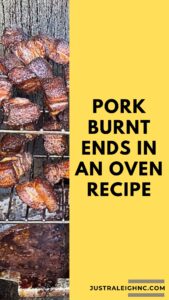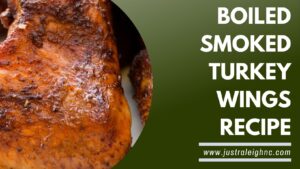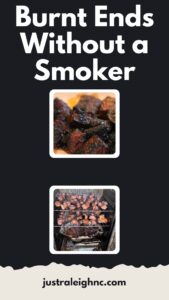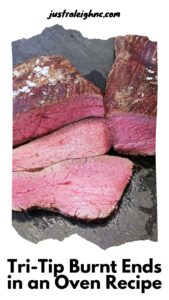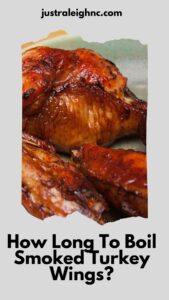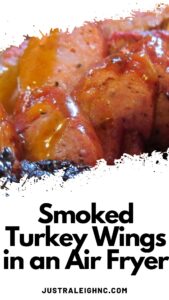This simple recipe for brisket burnt ends in an oven is a smokehouse delicacy. These are hunks of brisket seasoned with a homemade blend of spices and drenched in spicy BBQ sauce.
The smell is amazing, which will tempt you to sneak bites before the meat is even done.

This oven-roasted burnt ends recipe is perfect for enjoying BBQ without a smoker.
It does yield delectable, succulent, and crunchy brisket pieces, which are also perfect for feeding a crowd.
By the way, I suggest you add 1 to 2 teaspoons of liquid smoke if you prefer to buy a premade, sugar-free barbecue sauce.
This healthy recipe for oven-roasted burnt ends makes four servings, and one serving has 3 grams of net carbs.
How to Cook Brisket in the Oven
If you are unaware, incredible, flavor-packed, smoky, tender brisket can be made in your oven, which means you can make brisket burnt ends without needing a smoker.
This recipe features a mouth-watering dry rub, lip-smacking smoking liquid, which is also the perfect dipping sauce, and easy steps to make a crazy good piece of meat right in your oven.
Course: Main Course, Lunch
Cuisine: American
Prep Time: 25 minutes
Cook Time: 5 hours
Resting Time: 30 minutes
Total Time: 5 hours and 55 minutes
Servings: 4 servings (4-pound brisket)
Equipment
- Roasting pan with a wire rack
- Leave-in probe meat thermometer (highly recommended)
Ingredients
- 3 to 5 pounds of boneless beef brisket
Dry Rub
- 1 tablespoon of garlic powder
- 1 teaspoon of salt
- 1 teaspoon of smoked paprika
- 1 tablespoon of black pepper, or ½ tablespoon if you want less heat.
- 1 tablespoon of dark brown sugar
- 1 tablespoon of onion powder
- 1 tablespoon of chili powder
- 1 tablespoon of dried mustard
Smoking Liquid
- 1 tablespoon of tomato paste
- 2 cups of low-sodium beef broth (approximately) based on the size of the pan
- 2 tablespoons of liquid smoke
- ¼ cup of Worcestershire sauce
Laid-Out Instructions
- First, you are to preheat the oven to 250 degrees F. Get a roasting pan with a wire rack and add liquid smoke, tomato paste, Worcestershire sauce, and enough beef broth to fill the bottom of the pan without submerging the brisket, which will sit on the wire rack. Then, add enough broth so that it almost touches the bottom of the brisket, which will normally take 2 cups or more. After that, stir.
- That being done, trim the fat layer (the fat cap) so that there is around ¼ inch of fat still left on the brisket. Make sure you do not trim too much fat, or you will have a tough, bland brisket. Fat is flavor and moisture.
- Also, get a bowl and mix all the ingredients in the dry rub: brown sugar, chili powder, black pepper, garlic, dried mustard, onion powder, smoked paprika, and salt.
- Now, get a large plate and rub brisket with dry rub on it. Make sure you apply as much dry rub as possible to all surfaces of your brisket. You should use all or almost all of the dry. Then, transfer the brisket to the wire rack in your roasting pan, fat-side down. It’s okay if some of the rubs fall into the smoking liquid.
- After that, insert a leave-in probe thermometer into the center of the thickest part of your brisket. Ensure that the thermometer’s tip is not in the center of a fat layer, given that the temp will be inaccurate. Make sure you tightly cover your pan in foil, and if needed, you can poke a hole through the foil for the leave-in thermometer.
- It’s now time to cook the brisket in the oven until the thermometer reads around 190 degrees Fahrenheit in the thickest part. Remember that the cooking time varies depending on several factors. Excellent brisket is all about the temperature, not the time.
- When that is done, uncover the brisket and allow it to cook until it reads 200 to 205 degrees F and a thermometer can easily slide in and out of the brisket, as this shows a tender brisket.
Keep in mind that a stall might occur. Stall time means when the internal temp of your brisket stops rising and might even fall a few degrees. It might occur when you uncover your brisket and steam cools it down.
However, I strongly suggest that you recover your brisket with foil until your brisket’s temperature begins to rise steadily again; this is if a stall time lasts for more than 30 minutes.
Still, stalls sometimes never happen, happen once, or happen more than once.
Serving Suggestions
When it comes to burnt ends, nachos are just your best options. You can also serve them on a bed of tortilla chips with a layer of queso or beer cheese queso, pickled jalapenos, a scoop of apple baked beans, and a drizzle of barbecue sauce. You just can’t go wrong with these.
In addition, for a tasty appetizer, you can serve them with toothpicks or just load them onto rolls for a savory sandwich.
If you don’t know, smoked burnt ends are also perfect as a main course, along with all of your barbecue favorites.
For a simple meal made in one shot, you can also toss some corn on the cob or a few potatoes in the smoker with the meat.
Storing and Reheating Leftover Burnt Ends
Make sure you refrigerate any leftover brisket burnt ends that you have in a tightly sealed container.
And you can still enjoy it within 3 to 4 days, whether you want it cold from the fridge or warmed back up.
And, to reheat, you can reheat the meat in the oven (make sure it is no hotter than 325 degrees Fahrenheit), then switch to the broiler at the end if you want crunchy bits again.
Even an air fryer would be an excellent option for warming the meat back up.
How Do You Know When To Do Each Step Of This Recipe?
As previously mentioned, you must cook to temperature, not to the time when you are cooking anything, but specifically when you are cooking BBQ.
Briskets are extremely fickle, and they will take different amounts of time to cook depending on your smoker setup, the amount of fat in your brisket, and several other factors. So, you will need to use a meat thermometer to monitor the cooking.
You have the option of using a basic dial type of meat thermometer; however, I suggest you get a quality probe meat thermometer if you are going to cook meat regularly.
What Type of BBQ Sauce Should I Use?
The short and easy answer to the above question is your favorite. Just go with your favorite.
Brisket burnt ends are a Kansas City specialty, so I do suggest a Kansas City-style sauce that should be tomato-based with a dash of sweetness.
If you like, you can use a tangy version of a tomato-based sauce, however, keep in mind that this recipe won’t caramelize correctly without a sauce that has sugar in it, so for example, avoid using a Carolina-style mustard sauce.
Conclusion
You can also freeze brisket, but keep in mind that the texture might change a bit. You can freeze your brisket without the juices, but make sure that they are tightly wrapped. And, you also have the option of freezing it with the juices in a freezer-safe container for 4 to 5 months.
Well, it’s time to get cooking, as you now have the perfect recipe for brisket burnt ends in an oven.
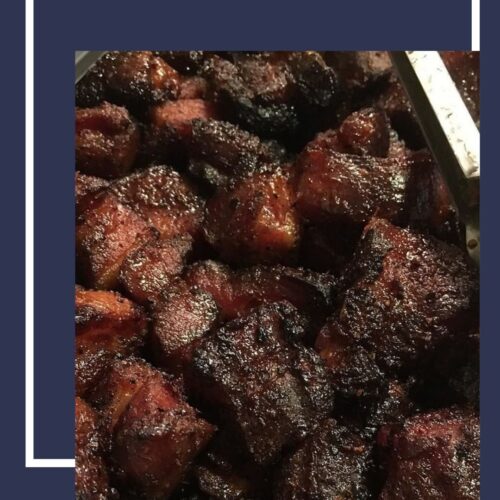
How to Make Brisket Burnt Ends in an Oven
Ingredients
- 1 boneless beef brisket weighing 3 to 5 pounds
Dry Rub:
- 1 tbsp garlic powder
- 1 tsp salt
- 1 tsp smoked paprika
- 1 tbsp black pepper or ½ tbsp for less heat
- 1 tbsp dark brown sugar
- 1 tbsp onion powder
- 1 tbsp chili powder
- 1 tbsp dried mustard
Smoking Liquid:
- 1 tbsp tomato paste
- Approximately 2 cups low-sodium beef broth adjust based on pan size
- 2 tbsp liquid smoke
- ¼ cup Worcestershire sauce
Instructions
- Preheat the oven to 250 degrees F.
- In a roasting pan with a wire rack, combine liquid smoke, tomato paste, Worcestershire sauce, and enough beef broth to fill the bottom of the pan without submerging the brisket.
- Place the brisket on the wire rack. Add more broth if needed, ensuring it almost touches the bottom of the brisket. Stir the liquid mixture.
- Trim the fat layer (fat cap) of the brisket to about ¼ inch, ensuring not to remove too much fat as it contributes to flavor and moisture.
- In a bowl, mix all dry rub ingredients: brown sugar, chili powder, black pepper, garlic, dried mustard, onion powder, smoked paprika, and salt.
- Rub the brisket generously with the dry rub, covering all surfaces. Transfer the brisket to the wire rack in the roasting pan, fat-side down. Some rub may fall into the liquid mixture, which is okay.
- Insert a leave-in probe thermometer into the center of the thickest part of the brisket, ensuring it’s not in the center of a fat layer for accurate temperature reading. Tightly cover the pan with foil, and if necessary, create a hole for the thermometer.
- Cook the brisket in the oven until the thermometer reads around 190 degrees Fahrenheit in the thickest part. Cooking time varies, focusing on temperature rather than time.
- Once the thermometer reads 190 degrees F, uncover the brisket and continue cooking until it reaches 200 to 205 degrees F. The brisket should be tender, and a thermometer should easily slide in and out.
